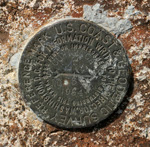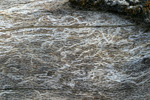I received this email from one of our soldiers that I’ve corresponded with. No comments are needed.
Hello everybody, this is Sgt. Furman from Mosul, Iraq again. After sending out my thank you letter, many people wrote back and asked that I try to send out updates on my progress in Iraq, some even suggested that I start my own blog. Well, time didn’t allow me to start my own blog, but as my deployment comes to an end, I thought I would write a final letter on my thoughts, and let everybody know that I made it through o.k..
The hot summer days and nights seem to have come to an end, and the days are now growing cooler as fall begins to sweep her hand over Northern Iraq. In a little over a month or so, I will be sitting on a plane headed back to the states, slowly leaving Iraq behind me with only my pictures, thoughts and memories to take with me. Even as I begin to pack it hasn’t set in that I am finally leaving this place that I have come to know with both hate and love so well.
This experience has been, and will no doubt be the most challenging of my life. When I first arrived here, I really wanted to hate this place. Try as I might, I found it impossible to hate Iraq. Although there is no place like the United States, Iraq is as beautiful a country as any. Sometimes you might have to look a little beyond the surface to find the beauty in it, but I assure you, it is there. There is no more an awe inspiring sight than that of an Iraqi night. While in the city of Tall Afar for a few days, I sat outside my “hooch” under the night sky and listened to the sound of 155mm Howitzers keep a thundering cadence on a distant target, and watched as a countless number of shooting stars passed over head. Under that same moon I have contemplated what my loved ones back home were doing at that very time; have had many great conversations with my fellow Soldiers; and let the lingering thoughts from the day pass out of my mind before I would go to sleep. And at times, it seems that Iraq had literally sucked all life from my body. There have been times that I felt that I was little more than a walking zombie.
The history and culture of Iraq has much to give to the world. I have found the Iraqi’s to be kind, loving, gentle and extremely resourceful. I feel that we have as much to gain from their friendship as they have to gain from ours. It seems to me that most Iraqi’s want nothing more than what the average American wishes for. A family to love, a home to come to at the end of the day, and most of all, the freedom that we all enjoy and love. It is my most sincere hope that they all get this and more.
As for the war itself, it is hard to put my thoughts and feelings into words, but will try to do my best. After a year of participation and observation, I can only say that war is horrible. Perhaps the most horrible of all actions. It’s not an adventure, or a right of passage. It’s visceral and evil. Carnage and violence at it’s worst. It is a place where one man willingly dispatches the life of another, lest that fate come to him. It is the only place where the amount of blood shed in the street is the measure by which you can judge success. It is not a movie that you can watch abstractly from the comfort of a theater seat. It is very real. It is a place where people die, and their loved ones are left heartbroken. At times it seems to be a living breathing entity. The most horrible monster you can imagine. It has no rhyme or reason, it just is. There is no point in trying to make sense of it, because there is no sense to be found in it. Yet, even through all of this, we have brave men and women who continue to charge into battle, and fight for all they can so others unknown to them may gain something from it.
Horrible as it is, it is a necessary evil. After a year, I still hold firm in my opinion that we are doing the right thing in Iraq. I don’t want you to mistake me for a warmonger, because that is as far from the truth as could be. I don’t believe there is a Soldier who is currently serving that is happy they are serving in a war. Don’t mistake pride of service for your country and your fellow man for joy of war. It is not the same. Believe me, the battles that are won here every day are not known to any human outside of the borders of this country. I don’t mean the major military victories that you can see on the news, or read in the paper, but the victories of the heart and will of the human. Every day an Iraqi awakes with the realization that they are free. That they can willfully speak their voice, right or wrong. Every day, as shown by the referendum, more and more Iraqi’s begin to place trust in their country, and in the protection that we are here to give to them. As contradictory as it might be, watching a country begin to take shape from this monster is an awesome thing to behold.
It will be hard for me to leave Iraq. Our time is done here, and now the battle is in another’s hands. I know that when I board that C-130 for my flight out of Mosul, and take my last breath of the Mosul air, that I will leave a piece of me in Iraq, and take a little piece of her home. She will be with me forever. The memories of her smiling children’s faces, the hot summer air, the gorgeous Arabian nights, and most assuredly, the thought of all the brave men and women who have fought and died for it all.
We have all followed the headlines of the vote in congress about a possible pullout of troops here. In my opinion (I want to make this clear, this is only my opinion, and I am only a Soldier, not a policy maker), a pullout at this time would be the most detrimental of all actions that our country could make, not to mention irresponsible. Truth be told, I don’t understand why there was ever a need for congress to even push the issue? What’s to debate? I will admit that I wasn’t completely sold on the war in Iraq in the beginning either, but after a year of witnessing the war for myself, I truly believe in what we are doing here. To me it doesn’t matter why we are, I am a Soldier, and go where I am ordered, but on a personal level, at the beginning, I thought hunting terrorists in Afghanistan was a more worth while fight. I was wrong. There are as many terrorists (not “insurgents”) here. I’m most certainly biased, but I’m certain that the U.S. Armed Forces are the best in the world, and I know for a fact that we are doing the best we can over here. Most of the Soldiers I have talked to feel exactly the same way. LET US DO OUR JOB! If we were to pullout now, everything that my unit has fought for this last year will be for nothing. Not to mention all of the men and women who suffer through severe injuries, and who’ve given their lives. It would be the ultimate of injustices to them to pullout now. Let us see this through to the end. If not for all the other reasons that I have mentioned; then for the simple fact, that it is unquestionably the right thing to do, and that all the people of Iraq, especially the children deserve it. I write this knowing full well, that I face the possibility of another deployment.
Many of us are looking to the future with optimism, both for Iraq, and our own lives. Some of us don’t know what the future holds for them, but will no doubt be just as successful as they were here. Unfortunately, for some, this war has taken a greater toll than just a year of life. Some of us have paid almost as much as the ones who will never again breath life, going home to broken lives due to the stress of being so far apart from their significant others. Personally, I will go back to my civilian job, and my family. I have a great girl that is waiting for me, and I just can’t wait to hold her in my arms again. Since I last wrote, I have re-enlisted in the guard for another 6 years (a sure sign I believe in what I preach), and don’t know if I will have to come back here again. If I do return here, I will hold my head high knowing that all of you great Americans back home are supporting me and have my back!
I just want to let all of you know that during the harder times in Iraq I have re-read some of the e-mails that you all have sent to me, and I still check the account for any new ones that might come my way. This has done wonders to lift my spirits at some very challenging times. Thank you! Please continue your support for us, and say thank you to any service member of any conflict that might come your way. They all deserve it. Maybe someday our lives might cross paths. If not, thank you again.
As I sit here and write this on Thanksgiving, although I have a lot to be thankful for this year, I thought I would share a little with you about what I am thankful for today. I am thankful for my family, they have been there for me, and without their guidance, I would be completely lost. I am thankful for God, that he has seen fit to protect me this last year, that he helps my battalion make it safely back home, that he continues to protect the troops that will still be here, and that he has taken into heaven with open arms, the men and women who have given their lives in this war, who he just couldn’t live without in heaven. I am thankful that I was born in America, and not a country like Iraq. As strange as it may seem, I am thankful that Americans still have the right to voice their opinions about this war (whether I agree with them or not), if America still has the right to voice it’s opinion, that means we’re doing our job over here, and doing it well! Most of all, I am thankful for my fiancé, who has braved one of the most ultimate in hardships this last year, and stuck with me throughout it all. For certain, true love does exist. Finally, I am thankful that there are people back home who understand what we are fighting for, and proud of us.
God Bless!
Sincerely,
Sgt, Furman
Mosul, Iraq
































